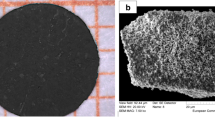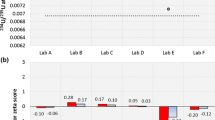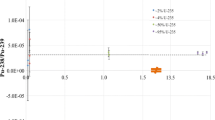Abstract
The objective of this study was to evaluate the spectral overlap for actinides and directly measure plutonium in uranium oxide and neptunium in uranium oxide matrix without an internal standard using laser ablation inductively coupled plasma-mass spectrometry (LA-ICP-MS). The system successfully measured 239Pu and 237Np with linear correlation coefficients (>0.99), relative standard deviations, limits of detections (0.026 and 0.111 wt% respectively) and percent biases reported. Each sample set was measured and analyzed within an hour which suggests a more rapid analytical technique than current methods used in nuclear safeguards to quantify plutonium and neptunium in a uranium matrix.





Similar content being viewed by others
References
Vais V, Li C, Cornett J (2004) Preventing uranium hydride formation in standard uranium samples for determination of 239Pu by ICP-MS. J Anal At Spectrom 19:1281–1283
Boulyga SF, Becker JS (2001) Determination of uranium isotopic composition and 236U content of soil samples and hot particles using inductively coupled plasma mass spectrometry. Fresenius J Anal Chem 370:612–617
Pointurier F, Hubert A, Faure A-L, Hemet P, Pottin A-C (2011) Polyatomic interferences in plutonium determination in the femtogram range by double focusing sector field ICP-MS. J Anal At Spectrom 26:1474–1480
Gunther-Leopold I, Kivel N, Waldis JK, Wernli B (2008) Characterization of nuclear fuels by ICP mass-spectrometric techniques. Anal Bioanal Chem 390:503–510
Ha YK, Kim J, Jeon YS, Han SH, Seo HS, Song K (2010) Local burnup characteristic of PWR spent nuclear fuels discharged from Yeonggwang-2 nuclear power plant. Nucl Eng Technol 42(1):79–88
Neeb KH (1997) The radiochemistry of nuclear power plants with light water reactors. Walter de Gruyter, NY
Bagnall KW, Laidler JB (1964) Neptunium and plutonium trioxide hydrates. J Chem Soc:2693–2696. doi:10.1039/JR9640002693
Richter K, Sari C (1987) Phase relationships in the neptunium-oxygen system. J Nucl Mater 148:266–271
Dukes EK, Shuler WE (1960) Report DP-543 declassified. Dupont de Nemours Co
Plaue J (2013) Forensic signatures of chemical process history in uranium oxides. Dissertation, University of Nevada Las Vegas
Wick OJ (1980) Plutonium handbook. American Nuclear Society, La Grange Park
Fultz B, Howe J (2013) Transmission electron microscopy and diffractometry of materials. Springer, Heidelberg
IUPAC (1997) Compendium of chemical terminology, 2nd ed. (the “Gold Book”). Compiled by A. D. McNaught and A. Wilkinson. Oxford, Blackwell Scientific Publications
Nelms SM (2005) Inductively coupled plasma mass spectrometry handbook. Blackwell Publishing Ltd, Oxford
Gastel M, Becker JS, Kuppers G, Dietze H-J (1997) Determination of long-lived radionuclides in concrete matrix by laser ablation inductively coupled plasma mass spectrometry. Spectrochim Acta, Part B 52(14):2051–2059
Nagayama K, Utsunomiya Y, Kajiwara T, Nishiyama T (2011) Pulse laser ablation by reflection of laser pulse at interface of transparent materials. In: Jakubczak K (ed) Lasers—Applications in Science and Industry. INTECH, Osaka
Raith A, Hutton RC, Abell ID, Crighton J (1995) Non-destructive sampling method of metals and alloys for laser ablation-inductively coupled plasma mass spectrometry. J Anal At Spectrom 10:591–594
Swartz ME, Krull IS (2012) Handbook of analytical validation. CRC Press, Boca Raton
Acknowledgments
This material is based upon work supported by the Department of Energy National Nuclear Security Administration under Award Number: DE-NA0000979 through the Nuclear Science and Security Consortium. This report was prepared as an account of work sponsored by an agency of the United States Government. Neither the United States Government nor any agency thereof, nor any of their employees, makes any warranty, express or limited, or assumes any legal liability or responsibility for the accuracy, completeness, or usefulness of any information, apparatus, product, or process disclosed, or represents that its use would not infringe privately owned rights. Reference herein to any specific commercial product, process, or service by trade name, trademark, manufacturer, or otherwise does not necessarily constitute or imply its endorsement, recommendation, or favoring by the United States Government or any agency thereof. The views and opinions of authors expressed herein do not necessarily state or reflect those of the United States Government or any agency thereof.
Author information
Authors and Affiliations
Corresponding author
Rights and permissions
About this article
Cite this article
Campbell, K., Unger, A., Kerlin, W. et al. Limiting spectroscopic interferences of 239Pu and 237Np in a UO2 matrix using LA-ICP-MS. J Radioanal Nucl Chem 310, 533–540 (2016). https://doi.org/10.1007/s10967-016-4854-x
Received:
Published:
Issue Date:
DOI: https://doi.org/10.1007/s10967-016-4854-x




